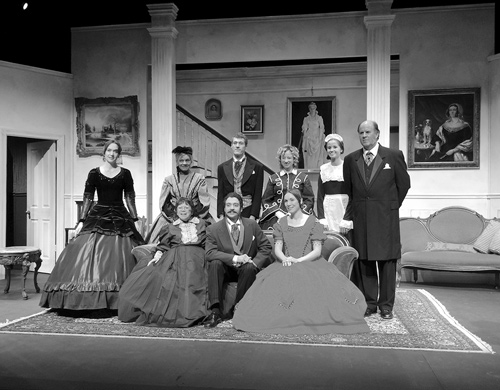News December 2014-January 2015
A passion for performance
In Dorset, community-theater tradition thrives in ninth decade
 By TELLY HALKIAS
By TELLY HALKIAS
Contributing writer
DORSET, Vt.
Members of The Dorset Players, seen here in this fall’s production of “The Heiress,” are apt to play many roles both on and off the stage. The community theater group has no artistic director; instead, its board makes group decisions about each season’s shows based on members’ suggestions.
Janet Groom’s day job advising students at the Community College of Vermont in Bennington is a performance requiring dexterity in human relations and no small amount of creativity.
But every few years, Groom feels the calling to hone her people skills in a different way, as a member of The Dorset Players, one of the nation’s longest-running community theater companies.
“I was one of those kids who held small theatrical events in my back yard in the summer time and charged neighborhood children to attend,” Groom recalled with a smile.
She occasionally performed in school productions, but her education in those post-World War II years led her in other directions.
“My parents encouraged us to get training in sensible career paths – not in anything as frivolous as acting,” Groom said.
Groom renewed her childhood fascination with acting in 1990 and eventually made her way back to scripted theater. Then, about 15 years ago, she auditioned with The Dorset Players for a part in “The Female Version of the Odd Couple.”
“I got the part, and voila, I began my relationship with the Players,” Groom said.
Although she has had several small roles since then in Dorset Players’ productions, she became more focused on directing.
“I had directed several college productions, but this was taking it to a new level,” Groom said.
The Dorset Players got its start in 1927 when, according to a history on the group’s Web site, a local couple, “Dr. and Mrs. Edward Goodman,” rallied a small group of local people to stage “39 East,” a 1920 work by the British playwright Rachel Crothers. The Goodmans successfully presented the three-act play at the Town Hall.
Within a few months, the group involved in that production had organized as The Dorset Players, a community theater troupe whose goal was, and still is, to bring quality plays to town, with local people doing the acting.
As they began to bring these shows to life, the group husbanded resources through donations and gate receipts and finally borrowed the balance needed to build a dedicated performance space. The result was the first Dorset Playhouse, which opened in 1929.
Sharing a new playhouse
The Players’ successful annual slate of community theater continued for several decades, except for a few seasons during World War II.
Then in 1976, John Nassivera and the late Jill Charles leased the Dorset Playhouse to produce their first season of professional theater through what became the Dorset Theatre Festival.
Kevin O’Toole, a local lawyer who has been with the Dorset Players for 28 years and serves as the group’s unofficial historian, said its association with the local Equity company, which will continue to lease the playhouse for six months of the year through 2039, has been long and fruitful.
“There is a mutual respect for the other’s mission to provide live theater to the Northshire and beyond,” O’Toole said.
One achievement of the alliance was construction of a new Dorset Playhouse in 2000-01.
“The old theater had 215 very cramped seats, limited facilities and partial sightlines,” O’Toole said. “In other words, you were uncomfortable when you sat, could not see the stage because of the person in front of you, and had to wait in line for the bathroom.”
The last of these problems required lengthier intermissions, he said.
The new facility has 296 seats with cushions on the back and plenty of legroom. The rake of the seats from front row to back row is 5.5 feet, so everyone has a good view of the stage. The lighting booth has an unobstructed view, and the new playhouse has larger dressing rooms and rehearsal spaces.
“You are now comfortable where you sit, can see the stage and can go to the bathroom without a wait,” O’Toole said.
The new facility allows both theater groups to work from their strengths. As amateurs, The Dorset Players can afford to produce musicals and plays with larger casts, such as “Oliver!” and this month’s “Miracle on 34th Street.” The Dorset Theatre Festival can focus on newer works with smaller professional casts and act as an incubator for aspiring and well-known playwrights.
In recent years, O’Toole added, the festival has been generous in lending its professional expertise to the amateur group when asked.
Joint decision-making
In keeping with its mission of community theater, The Dorset Players’ operations and direction are the result of shared governance.
“We don’t have an artistic director at The Dorset Players,” explained Sherry Kratzer, who has served in many capacities with the group including producer of this season’s opening show, “The Heiress.”
The organization’s board of directors, she said, makes a group decision about the upcoming season based on what directors, producers and the general membership put forth as suggestions.
“It would be easier to have one person choose and present the season to the board, but I don’t think it would fit the spirit of our community theater,” Kratzer said.
Lynne Worth, the current board president, also has filled multiple positions during her tenure with the Players and said the selection of plays and other events for the season, which runs October through May, is a process that can take up to a year.
“In the fall, the board will appoint a play reading committee to select several potential shows for consideration,” Worth said. “By January, we host a directors’ meeting for anyone interested in the following season. They may consider our ideas, or if they have a play they are passionate about, they may present that along with casting and production requirements and potential royalties.”
When the committee has considered all proposals, the proposed list goes to the board for a final decision. Worth said the members strive to balance the season with a variety of offerings -- comedy, drama, musicals and children’s theater.
She said it’s typical for a member to “move up the ranks.” Before directing a play, for example, a member must first have handled a broad cross-section of responsibilities, including acting, producing, stage managing and so on.
‘Miracle on 34th Street’
One of the members who’s done all kinds of things over nearly 25 years with the troupe is Angie Merwin, the director of the Players’ second 2014 show, “Miracle on 34th Street.” Merwin’s roles have mainly been offstage: directing, stage-managing, makeup, hair, construction and painting, props, sound, lighting and ushering.
“I have never produced a show, I don’t do costumes, and I haven’t acted since college,” Merwin said. “Typically I design and program most of the lighting for the shows that we do. I served on the board 12 years ago and was the president for three. This year I returned to the board as the membership coordinator.”
“Miracle” is the fifth play Merwin has directed for the Players, and she said each holds its own challenges.
“Last year, I directed the holiday production of ‘It’s a Wonderful Life, A Live Radio Play,’” Merwin said. “It was presented as an old-time radio show with live sound effects. The fun and challenge was finding all the sound effects we needed, from breaking spaghetti to building a wind machine.”
The challenge for “Miracle” is different, Merwin said. Its cast of 28 is large, and there are a dozen children between the ages of 10 and 14. Some of the children’s parents, who had no previous acting experience, are also in the show.
“Several cast members have been on our stage many times and know their way around,” Merwin said. “But we also have some newcomers who are familiar with stage work but not the playhouse. The children can’t be kept too late, and we must deal with all the missed rehearsals because of people’s schedules. These are amateurs. They learn lines in between real life and rehearsals. So I have rehearsals three or four nights a week and have different actors rehearse at different times.”
Behind-the-scenes support
Perhaps no one person better exemplifies the ethos of The Dorset Players than Tom Ferguson, who is working on earning professional status with the Actors Equity Association.
Last season, he devoted considerable time and effort to perfecting his role in the one-act classic “I Am My Own Wife.”
“I had only recently returned to the stage after a long absence, and the opportunity to play this role would be any actor’s dream,” Ferguson said. “I worked diligently off and on for six months with my director, Sherry Kratzer, and I knew I would be ready for the opening.”
Although there were no other actors on stage, Ferguson didn’t work in a vacuum. Other actors coached him, and he received support and guidance from the director, the stage manager and the entire technical crew.
“My teammates, if you will, consisted of 11 other people that never appeared on stage: not only the director and stage manager, but the scenic designer, costume and lighting designers, and the running crew -- all amateur volunteers,” Ferguson said.
Working with that group, he said, was an inspiration.
“We have one of the most beautiful theaters in all of Vermont at our disposal,” Ferguson said. “We have talented, experienced technicians who give their time and energy to help create a fully realized production. In helping me realize my dream, The Dorset Players represent, to me, the highest level of professionalism in a non-professional world.”
The Dorset Players’ final performances of “Miracle on 34th Street” are planned for 7:30 p.m. Friday and Saturday, Dec. 12 and 13, and 2 p.m. Sunday, Dec. 14 at The Dorset Playhouse in Dorset, Vt. For tickets and information, visit dorsetplayers.org or call (802) 867-5570.

